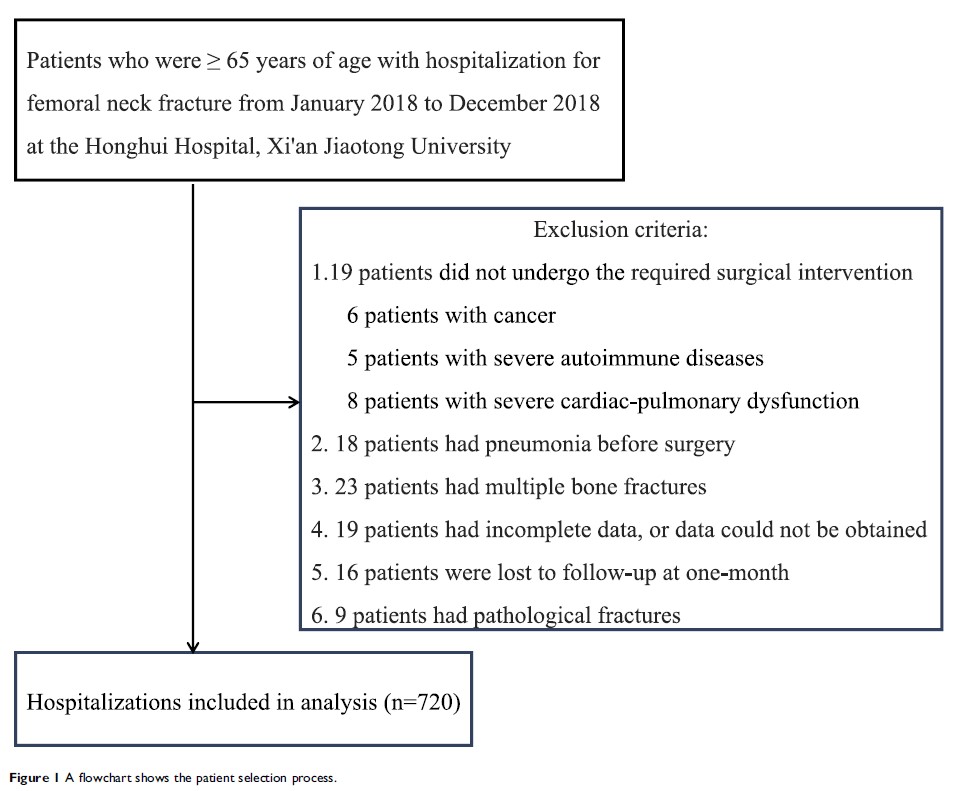9 0 8 0 2
论文已发表
注册即可获取德孚的最新动态
IF 收录期刊
- 2.6 Breast Cancer (Dove Med Press)
- 3.9 Clin Epidemiol
- 3.3 Cancer Manag Res
- 3.9 Infect Drug Resist
- 3.6 Clin Interv Aging
- 4.8 Drug Des Dev Ther
- 2.8 Int J Chronic Obstr
- 8.0 Int J Nanomed
- 2.3 Int J Women's Health
- 3.2 Neuropsych Dis Treat
- 4.0 OncoTargets Ther
- 2.2 Patient Prefer Adher
- 2.8 Ther Clin Risk Manag
- 2.7 J Pain Res
- 3.3 Diabet Metab Synd Ob
- 4.3 Psychol Res Behav Ma
- 3.4 Nat Sci Sleep
- 1.9 Pharmgenomics Pers Med
- 3.5 Risk Manag Healthc Policy
- 4.5 J Inflamm Res
- 2.3 Int J Gen Med
- 4.1 J Hepatocell Carcinoma
- 3.2 J Asthma Allergy
- 2.3 Clin Cosmet Investig Dermatol
- 3.3 J Multidiscip Healthc

术前血清白蛋白水平可作为老年人股骨颈骨折手术术后肺炎的预测因子
Authors Wang Y, Li X, Ji Y, Tian H, Liang X, Li N, Wang J
Received 19 September 2019
Accepted for publication 1 November 2019
Published 13 November 2019 Volume 2019:14 Pages 2007—2016
DOI https://doi.org/10.2147/CIA.S231736
Checked for plagiarism Yes
Review by Single-blind
Peer reviewers approved by Ms Georgia Watson
Peer reviewer comments 2
Editor who approved publication: Dr Zhi-Ying Wu
Purpose: Femoral neck fracture usually occurs in the geriatric population. Postoperative pneumonia (POP) is known to be devastated, and it is the most frequent complication among patients receiving surgical treatment for femoral neck fractures. However, whether patients who have hypoalbuminaemia are susceptible to the development of POP is a serious concern, although it has not been investigated. We attempted to investigate the association between newly developed POP and hypoalbuminaemia and to identify whether hypoalbuminaemia is an independent risk factor for POP after femoral neck fracture in geriatric population.
Patients and methods: We retrospectively reviewed the records from the first 30 days after surgery of patients who were ≥65 years of age and who had a femoral neck fracture treated with surgery between January 2018 and December 2018 at the Honghui Hospital, Xi’an Jiaotong University. Patients were divided into two groups based on whether they did or did not experience POP, and their clinical characteristics were compared. Binomial logistic regression was used to identify potential risk factors of POP by analysing demographic factors, preoperative comorbidities, laboratory results, and surgical factors.
Results: A total of 720 patients were included in the analysis, and 54 patients experienced POP. The incidence of POP after surgical treatment for a femoral neck fracture in this geriatric population was 7.5%. In addition, patients with POP had significantly longer hospital stays than patients without POP. The binary logistic regression analysis revealed that preoperative hypoalbuminaemia [odds ratio =5.187, 95% confidence interval (CI): 2.561–10.506, P<0.0001], COPD (OR =3.819, 95% CI: 1.247–11.701, P=0.019), prior stroke (OR =3.107, 95% CI: 1.470–6.568, P=0.003) and the time from injury to surgery (OR =1.076, 95% CI: 1.034–1.119, P<0.0001) were predominant and independent risk factors associated with POP after femoral neck fracture in this geriatric population.
Conclusion: The current study revealed that among a geriatric population admitted for femoral neck fracture surgery, preoperative hypoalbuminaemia was a predictor of POP, followed by COPD, prior stroke and the time from injury to surgery. Thus, patients who undergo femoral neck fracture surgery and have preoperative hypoalbuminaemia should receive additional monitoring and perioperative care.
Keywords: femoral neck fracture, nutrients, serum albumin, hypoalbuminaemia, postoperative pneumonia, risk factor
